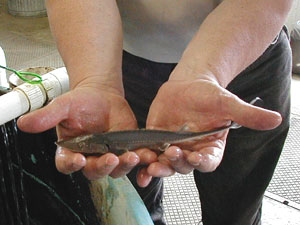Audio
Photos
Resources
Your Voice
| |||||||||||||||||||||||||||||||||||
Water Wars: Indicators on a beleaguered river
July 2, 2003
The Missouri River has been dammed and channeled for 50 years. The dams have allowed for barge traffic and flood control downstream, but changed the water flow upstream. In the last 20 years several native river species came close to extinction. Wildlife biologists say the endangered birds and fish are an indication of the health of the river. Federal law requires a recovery program.
Yankton, SD — Herb Bollig talks about Missouri River paddle fish like some people talk about their pets.
 | |||
"See how they swarm there. It's really cute. I think they're really neat," he says while standing over a tank stocked with 5,000 newly hatched paddle fish. Bollig is the manager at the Gavins Point National Fish Hatchery in Yankton, South Dakota. The hatchery raises and stocks several kinds of fish. They include paddle fish, walleye and rainbow trout. But for the last 12 years, the mission here has been to increase the population of one ancient fish -- the pallid sturgeon. There are more pallid sturgeon here of different ages, than any hatchery in the world. Bollig drops the water level in one 500-gallon tank. About 150 pallid sturgeon slowly come into view. The one-year-old fish are only about seven inches long. They're closely related to the paddle fish. But the pallid sturgeon is unique. It's a prehistoric mix of fish and dinosaur. It has a tail like a shark. A head that is flat, like the airfoil on an airplane. That helps them maneuver along the river bottom. Pallid sturgeon don't have scales. Their skin is thick and slimy with fins that resemble the backs of dinosaurs. The ridges are called scoots.
"It's got these scoots here. It's got five rows of scoots on the side -- two on this side, two on this side and one on the top. It's like a razor, like a saw blade," Bollig says.
The pallid sturgeon was declared an endangered species in 1990. It's native to the Missouri River. Biologists say the decline in population is an indicator of an unhealthy river. It's a sign that something has to change.
Since the Missouri River dams were built the pallid sturgeon have stopped spawning in the wild. The fish lives 50 to 60 years and can weigh up to 80 pounds. The pallid sturgeon take an incredibly long time to mature. It's 15 years before a female fish produces eggs. At that rate Herb Bollig may never see more than two generations in this hatchery.
"These fish are native to the old Missouri River and the Mississippi. They're native to the old characteristics of the river. The old sand bars, and braided channels and the flooding in the spring and the natural run off and the increase in runoff in the spring. There's a lot of these cues that are there that the fish need in order to reproduce," he says.
 | |||
The pallid sturgeon are released into the Missouri River when they reach 15 inches long. Each fish is tagged and numbered. If fishermen catch a pallid sturgeon they're asked to report information about the fish and release it. Some fish are kept at the hatchery each year to create future generations.
But over the past few generations, the Missouri River has changed. After several deadly floods in the 1940s, the Army Corps of Engineers was charged with building huge dams to control water flow. The change has affected not only fish, but birds as well. The Piping Plover and the Interior Least Tern thrived with an unstable river. Now they're endangered.
"It was unpredictable," says Casey Kruse, the chief of endangered species with the Army Corps of Engineers. "It ate acres and cows and farms in one night. These birds evolved with that system. They're capable of moving great distances to find suitable nesting areas and quickly reproduce in high numbers. In poorer years when we typically had higher water longer along the river these birds may not have nested successfully at all."
Kruse says the problem now, is there aren't as many places for them to nest. And they're more vulnerable. A large population could nest on a sand bar and one predator or storm could wipe the nests out. Kruse says the key is to expand the nesting habitat.
 | |||
"If you have high quality habitat and lots of it that means you have habitat which will keep the birds from being flooded. You have lots of habitat which keeps the predators from being as effective and when you have lots of habitat and lots of sites you may have a hail storm that removes 10 or 20 nests versus a hundred or 200 nests when it passes through a reach of the river," says Kruse.
A sand bar is a perfect example of nesting habitat. Greg Pavelka wishes there were more sand bars along this stretch of the Missouri River. Right now there are 15. Pavelka is a wildlife biologist with the Army Corps of Engineers. His job is to count birds and track nests. On the Missouri River there are only 1,000 Piping Plovers and 700 Least Terns.
The Piping Plover eats insects and lines its sandy nest with small pebbles. The eggs blend in. But the offspring are fair game for many species. Raccoons and mink steal the eggs. When the chicks hatch, owls use them to train their own young how to hunt. That's why it's important to have enough sand bars on the river so the nesting birds spread out.
"Those are Least Terns; you can see that one has a fish in his mouth. The terns are fish eaters its probably going back to its mate that's on the nest right now," says Pavelka, who sees this nest on a sand bar that's covered with orange twine. It looks a bit like a crime scene. But the idea is to keep people away. In fact, violators face a $500 fine if they trespass.
Many scientists and environmentalists say fish and bird species will really rebound, only if water levels fluctuate. Before the dams, the natural river got a scouring each spring. High waters also created sandbars for nesting birds and signaled spawning season for fish.
Now the water is held back in the spring and released in the summer. The summer release floods the sand bars and kills young birds. The Army Corps of Engineers manages the water releases.
The commander of the northwest division, Brigadier General David Fastabend, says there are two congressional mandates that dictate how to run the system. One is the Flood Control Act of 1944 and the other is the Endangered Species Act. Each tell him to do two different things.
"If you want to maximize the potential benefits for the endangered species you might run the system one way. Or if you wanted to maximize economic benefits you'd run it another way. There are conflicts but they're not necessarily contradictory.
Fastabend says to follow the law there has to be a middle ground. He's confident it exists. But another commander will make that call. Fastabend leaves his post this month. In the mean time the courts may make the decision. Environmental groups have sued the Corps to force changes in management of the Missouri river.
|
News Headlines
|
Related Subjects
|


